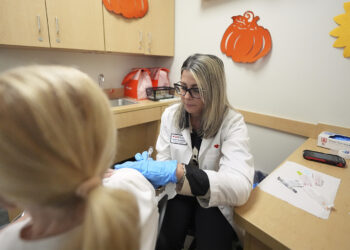TOPLINE:
In a US real-world analysis, only 51.5% of children with vitiligo received any treatment within 2 years of diagnosis, less often than adults.
METHODOLOGY:
- Researchers analyzed data from the TriNetX US Collaborative Network of patients with two or more medical claims for vitiligo.
- The study included 5253 adults and an equal number of sex- and race-matched pediatric patients.
- Treatment included phototherapies (narrowband ultraviolet [UVB], psoralen and UVA [PUVA], and excimer laser), topical treatments (calcineurin inhibitors, corticosteroids, calcipotriene, and ruxolitinib), and systemic therapies (corticosteroids and oral immunomodulators).
- Outcomes were prescribing patterns in children within 1 year of diagnosis and treatment initiation rates in adult and pediatric patients within 2 years post-diagnosis.
TAKEAWAY:
- In 2024, topical corticosteroids were the most commonly prescribed treatment in children (73.0%), followed by systemic corticosteroids (57.0%), topical calcineurin inhibitors (49.8%), and topical ruxolitinib (11.3%), approved by the FDA for treating nonsegmental vitligo in patients aged 12 years or older.
- Within 2 years of diagnosis, 51.5% of pediatric and 56.1% of adult patients received treatment, indicating that treatment initiation rates were significantly lower among pediatric patients than among adult patients (hazard ratio [HR], 0.91; 95% CI, 0.86-0.96).
- Pediatric patients had lower treatment initiation rates across all modalities than adults: phototherapy (HR, 0.82; 95% CI, 0.71-0.94), topical treatment (HR, 0.92; 95% CI, 0.87-0.97), and systemic therapy (HR, 0.63; 95% CI, 0.59-0.67).
IN PRACTICE:
This study showed that “48.5% of children with vitiligo remained treatment-free within 2 years post-diagnosis” and had a lower probability of starting treatment than adults, the authors wrote. Factors that might contribute to this difference, they added, included disease recognition, considering lack of access to pediatric dermatology care in some areas, and “insurance providers classifying vitiligo as a cosmetic rather than medical condition leading to limited coverage and access, particularly to newer therapies.”
SOURCE:
This study was led by Serena Yun-Chen Tsai, MD, MMSc, Department of Dermatology, Massachusetts General Hospital, Boston. It was published online on July 2 in the Journal of the American Academy of Dermatology.
LIMITATIONS:
This study relied on coded diagnoses and excluded patients with only one encounter, possibly inflating treatment rates. Disease severity, location, and care outside TriNetX sites were not captured.
DISCLOSURES:
The authors reported having no funding information. One author received funding from the Society for Pediatric Dermatology/Pediatric Dermatology Research Alliance. Two authors reported receiving advisory fees and having ties with Alys Pharmaceuticals, Avoro, Barinthus Bio NA, Cour Pharma, Incyte, Matchpoint Therapeutics, NexImmune, Vividion, and Sanofi.
This article was created using several editorial tools, including AI, as part of the process. Human editors reviewed this content before publication.
Source link : https://www.medscape.com/viewarticle/study-treatment-delayed-half-us-children-vitiligo-2025a1000hwk?src=rss
Author :
Publish date : 2025-07-07 13:08:00
Copyright for syndicated content belongs to the linked Source.








